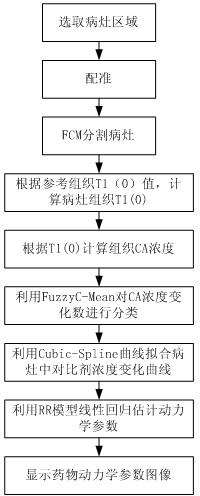Quantitative analysis method based on lung MRI (magnetic resonance imaging) dynamic enhancement scanning
A dynamic enhancement and quantitative analysis technology, applied in the field of medical quantitative analysis, can solve the problems of measurement and calculation error, time-consuming calculation, hindering actual field application, etc., to achieve the effect of improving calculation efficiency and reducing work intensity
- Summary
- Abstract
- Description
- Claims
- Application Information
AI Technical Summary
Problems solved by technology
Method used
Image
Examples
Embodiment Construction
[0020] The reference region model (Reference Region Model) solves the need to directly measure the concentration change parameters (Artery Input Function) of the contrast agent in the artery. By measuring the concentration change of the reference region (usually the muscle tissue near the tumor), the The concentration change in the tumor area was used to obtain the relevant kinetic parameters. The Fuzzy C-Mean algorithm was introduced into DCE-MRI breast segmentation and pharmacokinetic classification. This method can classify clusters according to the change curve of the data, and can effectively solve the impact of noise on the data. The fixed T1 algorithm solves the conventional calculation of T1 images with multiple inversion angles, saves the number of scans of the patient, and greatly simplifies the calculation of T1 images. The present invention will combine the above several technologies and apply it to the quantitative analysis of DCE-MRI of the lungs. It adopts a fix...
PUM
 Login to View More
Login to View More Abstract
Description
Claims
Application Information
 Login to View More
Login to View More - R&D
- Intellectual Property
- Life Sciences
- Materials
- Tech Scout
- Unparalleled Data Quality
- Higher Quality Content
- 60% Fewer Hallucinations
Browse by: Latest US Patents, China's latest patents, Technical Efficacy Thesaurus, Application Domain, Technology Topic, Popular Technical Reports.
© 2025 PatSnap. All rights reserved.Legal|Privacy policy|Modern Slavery Act Transparency Statement|Sitemap|About US| Contact US: help@patsnap.com


